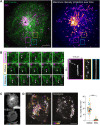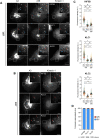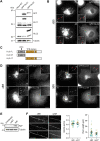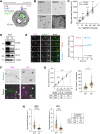Kinesin-1 transports morphologically distinct intracellular virions during vaccinia infection
- PMID: 36093836
- PMCID: PMC9659004
- DOI: 10.1242/jcs.260175
Kinesin-1 transports morphologically distinct intracellular virions during vaccinia infection
Abstract
Intracellular mature viruses (IMVs) are the first and most abundant infectious form of vaccinia virus to assemble during its replication cycle. IMVs can undergo microtubule-based motility, but their directionality and the motor involved in their transport remain unknown. Here, we demonstrate that IMVs, like intracellular enveloped viruses (IEVs), the second form of vaccinia that are wrapped in Golgi-derived membranes, recruit kinesin-1 and undergo anterograde transport. In vitro reconstitution of virion transport in infected cell extracts revealed that IMVs and IEVs move toward microtubule plus ends with respective velocities of 0.66 and 0.56 µm/s. Quantitative imaging established that IMVs and IEVs recruit an average of 139 and 320 kinesin-1 motor complexes, respectively. In the absence of kinesin-1, there was a near-complete loss of in vitro motility and reduction in the intracellular spread of both types of virions. Our observations demonstrate that kinesin-1 transports two morphologically distinct forms of vaccinia. Reconstitution of vaccinia-based microtubule motility in vitro provides a new model to elucidate how motor number and regulation impacts transport of a bona fide kinesin-1 cargo.
Keywords: In vitro motility assays; Kinesin-1; Microtubule transport; Vaccinia virus.
© 2022. Published by The Company of Biologists Ltd.
Conflict of interest statement
Competing interests M.W. is the Editor-in-Chief at Journal of Cell Science but was not included in any aspect of the editorial handling of this article or the peer review process. The remaining authors declare no competing or financial interests.
Figures








Similar articles
-
Movements of vaccinia virus intracellular enveloped virions with GFP tagged to the F13L envelope protein.J Gen Virol. 2001 Nov;82(Pt 11):2747-2760. doi: 10.1099/0022-1317-82-11-2747. J Gen Virol. 2001. PMID: 11602786
-
Kinesin-dependent movement on microtubules precedes actin-based motility of vaccinia virus.Nat Cell Biol. 2001 Nov;3(11):992-1000. doi: 10.1038/ncb1101-992. Nat Cell Biol. 2001. PMID: 11715020
-
Kinesin-1 Proteins KIF5A, -5B, and -5C Promote Anterograde Transport of Herpes Simplex Virus Enveloped Virions in Axons.J Virol. 2018 Sep 26;92(20):e01269-18. doi: 10.1128/JVI.01269-18. Print 2018 Oct 15. J Virol. 2018. PMID: 30068641 Free PMC article.
-
One axon, many kinesins: What's the logic?J Neurocytol. 2000 Nov-Dec;29(11-12):799-818. doi: 10.1023/a:1010943424272. J Neurocytol. 2000. PMID: 11466472 Review.
-
Move in for the kill: motile microtubule regulators.Trends Cell Biol. 2012 Nov;22(11):567-75. doi: 10.1016/j.tcb.2012.08.003. Epub 2012 Sep 6. Trends Cell Biol. 2012. PMID: 22959403 Free PMC article. Review.
Cited by
-
Monkeypox virus spreads from cell-to-cell and leads to neuronal death in human neural organoids.Nat Commun. 2025 Jun 30;16(1):5376. doi: 10.1038/s41467-025-61134-0. Nat Commun. 2025. PMID: 40588500 Free PMC article.
-
The amount of Nck rather than N-WASP correlates with the rate of actin-based motility of Vaccinia virus.Microbiol Spectr. 2023 Dec 12;11(6):e0152923. doi: 10.1128/spectrum.01529-23. Epub 2023 Oct 19. Microbiol Spectr. 2023. PMID: 37855608 Free PMC article.
-
HIV-1 binds dynein directly to hijack microtubule transport machinery.Sci Adv. 2025 Jun 20;11(25):eadn6796. doi: 10.1126/sciadv.adn6796. Epub 2025 Jun 18. Sci Adv. 2025. PMID: 40532013 Free PMC article.
-
Single-cell analysis of VACV infection reveals pathogen-driven timing of early and late phases and host-limited dynamics of virus production.PLoS Pathog. 2024 Aug 2;20(8):e1012423. doi: 10.1371/journal.ppat.1012423. eCollection 2024 Aug. PLoS Pathog. 2024. PMID: 39093901 Free PMC article.
-
Multi-omics characterization of the monkeypox virus infection.Nat Commun. 2024 Aug 8;15(1):6778. doi: 10.1038/s41467-024-51074-6. Nat Commun. 2024. PMID: 39117661 Free PMC article.
References
Publication types
MeSH terms
Substances
Grants and funding
LinkOut - more resources
Full Text Sources
Research Materials

